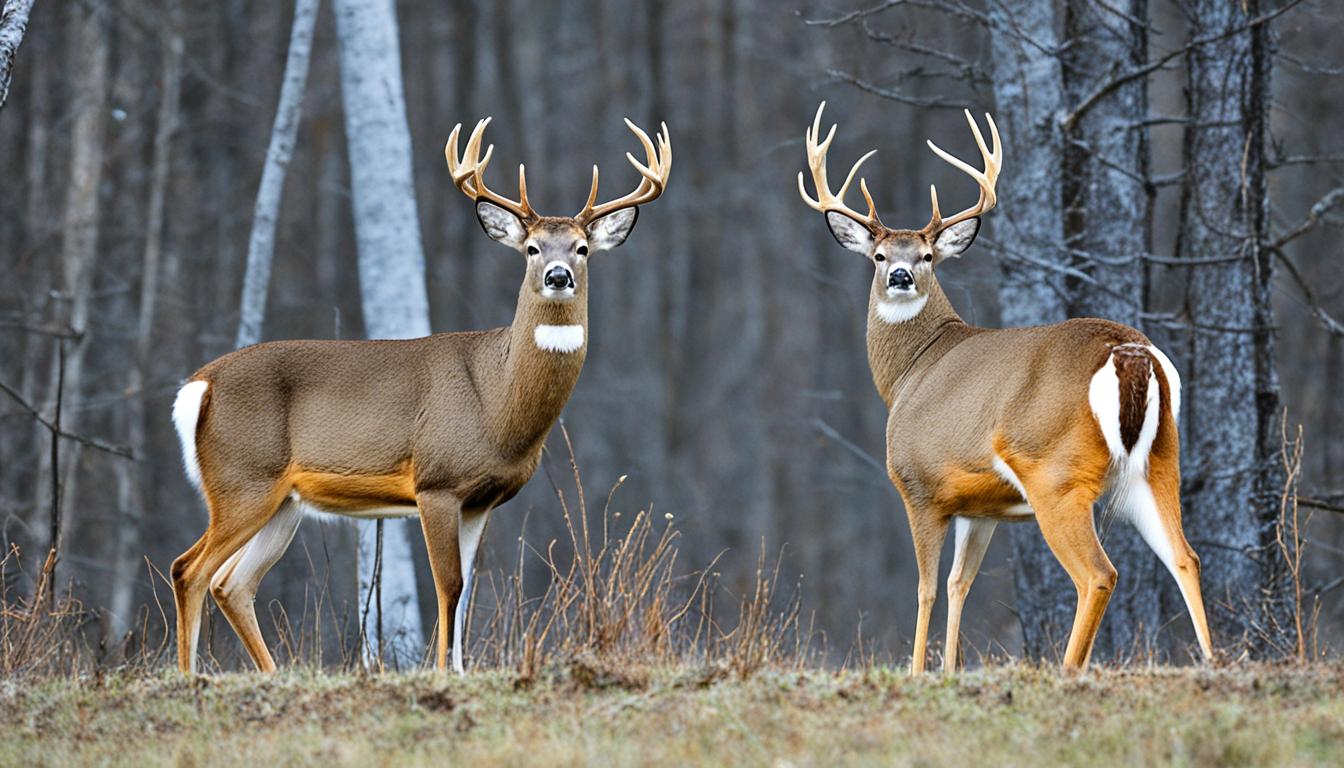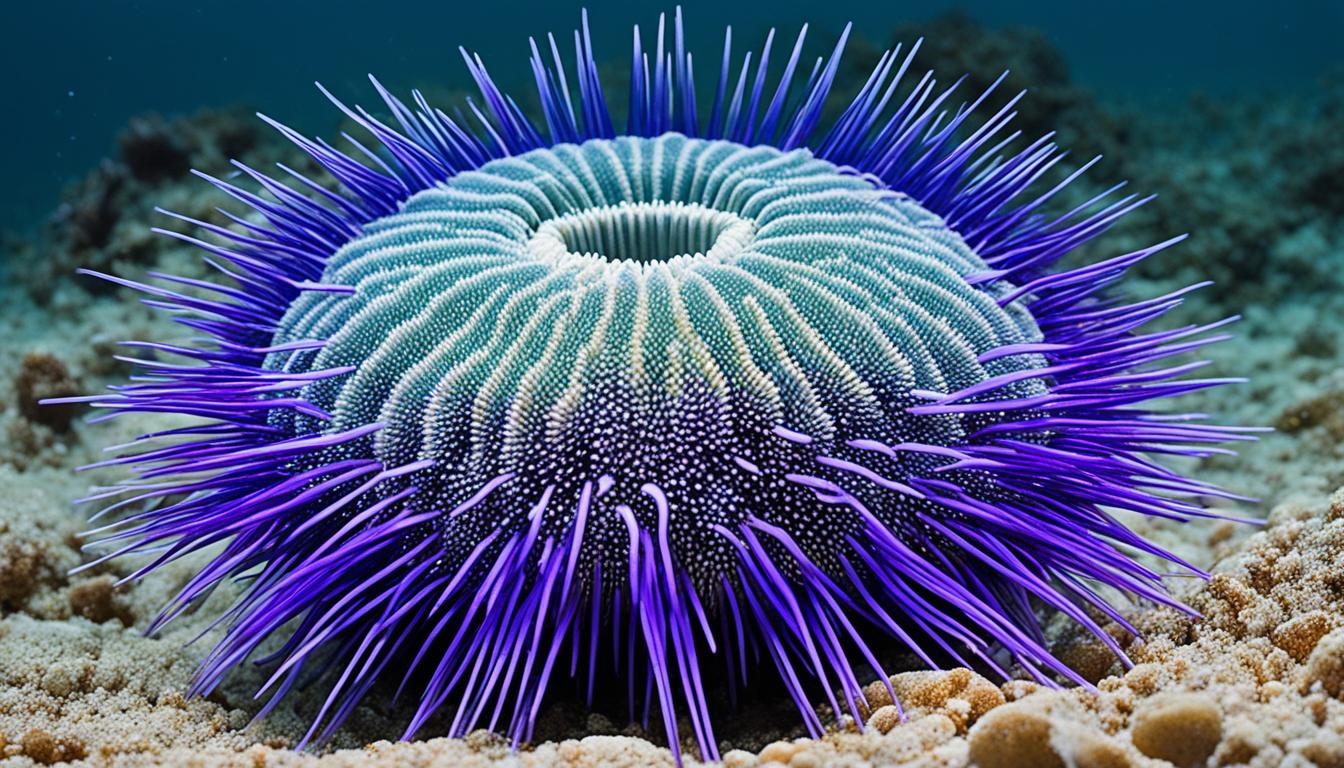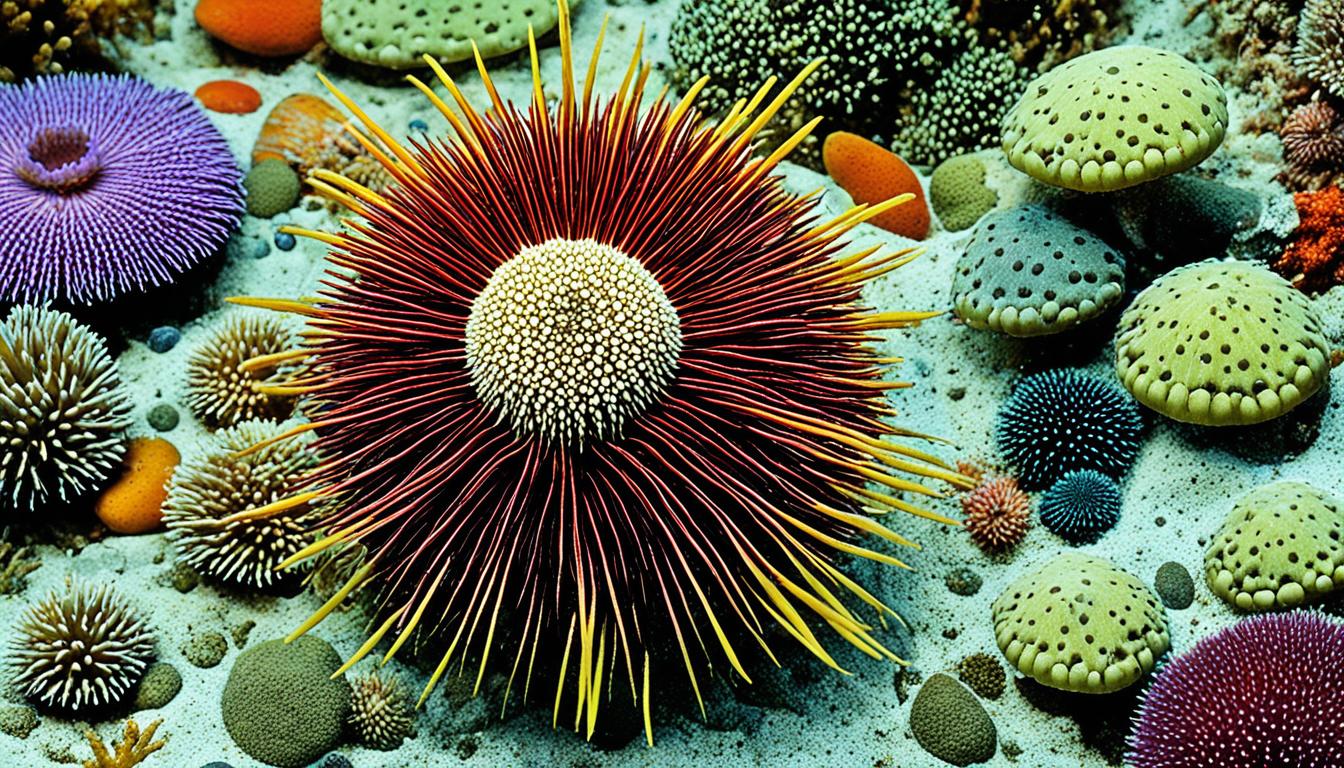Ever been in nature and wondered about telling a mule deer from a white-tailed deer? At first glance, they might look alike, but there are big differences. You can spot these by looking at their ears, tails, and antlers.
So, are you ready to become an expert on deer identification? With a little attention, telling mule deer and white-tailed deer apart is simpler than it seems.
Introduction to Mule Deer and White-tailed Deer
Mule deer have big ears, thus their name. White-tailed deer got their name from their white tails’ underside. Both are in the Odocoileus genus but differ in looks and behavior.
To compare mule deer vs white-tailed deer, knowing their traits is key. Mule deer prefer western North America’s various areas. White-tailed deer, however, mainly inhabit the eastern and central regions.
Comparing mule deer and white-tailed deer uncovers unique traits. These help them fit into their environments. For example, mule deer do well in dry areas with low bushes. In contrast, white-tailed deer excel in forests and dense vegetation.
Here’s a quick look at the differences between the two:
| Characteristic | Mule Deer | White-tailed Deer |
|---|---|---|
| Ear Size | Large, similar to a mule’s ears | Smaller, rounded |
| Tail | White with a black tip | Brown on top, white underneath |
| Habitat | Arid regions, brush areas in the West | Woodlands, thickets across North America |
Understanding the mule deer vs white-tailed deer characteristics is crucial. It helps with deer species comparison. This knowledge is vital for those interested and for conservation efforts created to suit each species.
Physical Appearance Differences
At first glance, telling mule deer and white-tailed deer apart can be tricky. They look somewhat similar, but there are key things that make them different. For instance, their ears show a big contrast. Mule deer have big, pointy ears that stick out. White-tailed deer, on the other hand, have smaller, rounder ears.
Ear Size and Shape
Mule deer really stand out with their ear shape. They have ears that remind you of mules, large and long. In contrast, white-tailed deer have ears that are more modest in size and circular.
Facial Coloration
Looking at their faces also helps in telling them apart. Mule deer have a white face with a dark forehead. This creates a stark contrast. Meanwhile, white-tailed deer have a brown face. It’s marked with white around their eyes and nose.
Body Color and Texture
Colors and textures on their body change with the season. Mule deer tend to have a grayish-brown fur. This coloring helps them hide in deserts and arid terrains. White-tailed deer, in contrast, sport a more reddish-brown fur. They live in forested areas where this color helps them hide.
Below is a detailed comparison to help with your observations:
| Feature | Mule Deer | White-tailed Deer |
|---|---|---|
| Ear Size and Shape | Large, elongated | Small, rounded |
| Facial Coloration | White face, dark forehead | Brown face, white around eyes and nose |
| Body Color and Texture | Grayish-brown coat | Reddish-brown coat |
The Tail: A Clear Identifier
The tail is key in telling mule deer and white-tailed deer apart. Mule deer have a small, white tail with a black tip end. This marking is vital for figuring out deer type, especially when they’re moving away.
Comparatively, white-tailed deer’s tails are bigger, brown on top, and white underneath. It’s how you recognize them by their tail. This is very evident in their ‘flagging’ action.
It’s crucial to know these distinct features to spot the difference. By looking at the tail’s color and size, you can quickly figure out the deer type. This is useful for both the wild or looking at pictures, making you better at identifying deer by their tail.
| Feature | Mule Deer | White-tailed Deer |
|---|---|---|
| Tail Color | White with black tip | Brown on top, white underneath |
| Tail Size | Small | Large |
| Alarm Behavior | Limited tail movement | ‘Flagging’ with raised tail |
Antler Structure and Growth
Antlers help tell the difference between mule deer and white-tailed deer. This makes it easier for fans and experts to spot the species they’re interested in. Let’s talk about antler details, how they shed, and the differences between these deer.
Mule Deer Antlers
Mule deer antlers are special because they split as they grow. They form a unique shape that stands out. These antlers show the deer’s condition and are key in their mating behavior.
White-tailed Deer Antlers
On the other hand, white-tailed deer antlers don’t split. They have one main beam with many smaller points. This design tells of the species’ specific changes over time. The antlers help in fighting for dominance and attracting mates.
Seasonal Antler Shedding
Both types of deer lose their antlers once a year, but at different times. The shedding follows a yearly pattern that ties to their health and environment. Mule deer usually drop their antlers from late February to March, while white-tailed deer do so from January to February. Knowing these shed times can aid in species identification.
| Aspect | Mule Deer | White-tailed Deer |
|---|---|---|
| Antler Structure | Bifurcated, Forked | Single Main Beam with Tines |
| Shedding Time | February – March | January – February |
| Antler Function | Mating Displays, Health Indicator | Dominance, Mating Displays |
Behavioral Characteristics
Learning about mule deer vs white-tailed deer behavior is interesting. It helps us tell them apart. One key difference is how they move. Mule deer have a special hop, called “stotting” or “pronking”. On the other hand, white-tailed deer run fast when they’re scared.
Understanding how deer species warn others matters too. White-tailed deer signal by flagging their tails, showing the white underside. This warns other deer. Mule deer, however, don’t show this alarm signal. This shows a clear difference in wildlife behavior.
Making out if you’re looking at a mule deer or a white-tailed deer is easier with these clues. Remember:
| Aspect | Mule Deer | White-tailed Deer |
|---|---|---|
| Movement Style | Bounding hop (stotting) | Galloping run |
| Alarm Signal | No specific tail movement | Flagging (tail raising) |
Habitat Preferences
Mule deer and white-tailed deer live in very different places. Mule deer are usually in dry regions in the west of the United States. They like open plains, mountains, and places with a lot of brush. This kind of area is perfect for them because they can handle the dry, tough weather.
White-tailed deer, on the other hand, have a wider variety of places they call home. You can find them in the woodlands and thickets across the eastern and western parts of the U.S. They do well in forests, grasslands, and places where people grow crops. They’re known for being able to live in many kinds of environments. This means their homes cover a bigger area than mule deer’s homes.

Because they live in such different places, mule deer and white-tailed deer have evolved differently. Mule deer prefer arid, open areas. White-tailed deer, however, are used to forests and mixed lands. This shows how deer species have found ways to live in a wide range of habitats in North America.
The following table shows how the habitats of mule deer and white-tailed deer differ:
| Feature | Mule Deer Habitat | White-tailed Deer Habitat |
|---|---|---|
| Location | Western United States | Western and Eastern United States |
| Preferred Environment | Arid, brush areas | Woodlands, thickets |
| Adaptability | Adapts to dry, open regions | Highly adaptable, various environments |
Studying where each deer likes to live can tell us a lot about them. It helps in recognizing them in the wild, too.
Size and Weight Comparisons
Distinguishing mule deer from white-tailed deer is key. Important differences lie in their size and weight. These help us spot them apart.
Mule Deer Body Size
Mule deer are larger than white-tailed deer. Adult bucks usually weigh 125 to 250 pounds. But, some can get over 450 pounds.
White-tailed Deer Body Size
White-tailed bucks are lighter, at 130 to 220 pounds. However, in cold places, they might grow as big as 400 pounds. This shows their ability to live in many areas.
Gestation and Mating Seasons
Mule deer and white-tailed deer have very different mating seasons. These seasons affect how they behave and continue their species.
Mule Deer Mating Habits
From mid to late November, mule deer males fight for females. Bucks use their antlers to prove they are the strongest. This time is key for mule deer to grow their population. After mating, does carry their young for about seven months. Fawns are born in the late spring or early summer.
White-tailed Deer Mating Habits
White-tailed deer mate a bit later, from late November through early December. Bucks have unique ways to attract females, like scraping and rubbing to mark their area. It’s also a time to show who’s boss. This species has shorter pregnancies, about six and a half months. That means their fawns arrive in the late spring. These differences show the unique mating patterns of white-tailed deer.
Mule deer breeding season and breeding behaviors set them apart from white-tailed deer.
| Aspect | Mule Deer | White-tailed Deer |
|---|---|---|
| Breeding Season | Mid to Late November | Late November to Early December |
| Gestation Period | 7 Months | 6.5 Months |
| Fawning Time | Late Spring to Early Summer | Late Spring |
Fawn Characteristics
Mule deer fawns and white-tailed deer fawns have slight differences. They both are born in late spring to early summer, a time that’s best for young deer. They have a reddish coat with white spots for camouflage, keeping them safe from predators when they are young.
The time they spend with their mothers differs between the species. Mule deer fawns leave their mothers earlier than white-tailed deer fawns. This means they must learn to be independent quickly. Mule deer fawns are known to stand up and nurse soon after birth, showing their early ability to take care of themselves.
The camouflaged coats on these fawns change as they grow. Mule deer fawns’ spots fade by the end of summer, making them look more like adult deer. White-tailed deer fawns might keep their spots a bit longer. Knowing these changes is important for people who enjoy wildlife and those who study them.










